1. Introduction
The aim of this document is to describe the architecture of the solution, first by defining the business concepts it deals with and then showing how this translates into the technical architecture.
2. Business Architecture
OperatorFabric is based on the concept of cards, which contain data regarding events that are relevant for the operator. A third party tool publishes cards and the cards are received on the screen of the operators. Depending on the type of the cards, the operator can send back information to the third party via a "response card".
2.1. Business components
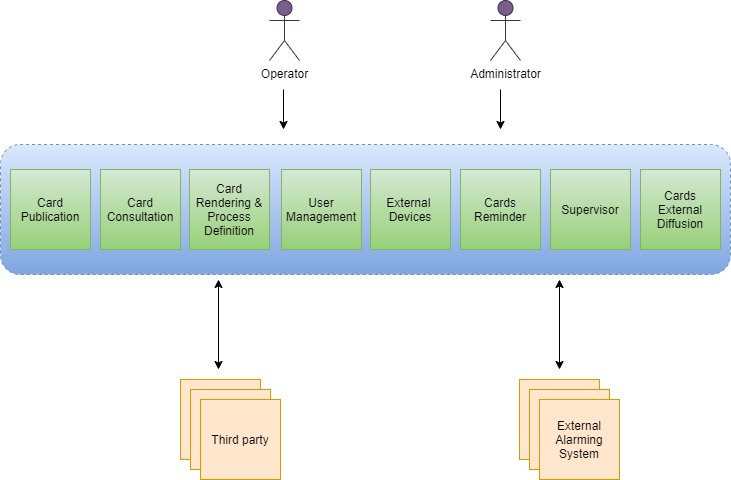
To do the job, the following business components are defined :
-
Card Publication : this component receives the cards from third-party tools or users
-
Card Consultation : this component delivers the cards to the operators and provide access to all cards exchanged (archives)
-
Card rendering and process definition : this component stores the information for the card rendering (templates, internationalization, …) and a light description of the process associate (states, response card, …). This configuration data can be provided either by an administrator or by a third party tool.
-
User Management : this component is used to manage users, groups, entities and perimeters.
-
External devices : this optional component permit to send alarm to an external device instead of playing a sound on the user computer. For now, only one driver exists using modbus protocol.
-
Cards Reminder : this component is used to handle cards reminders.
-
Cards External Diffusion : this optional component allows to send cards notifications via email
-
Supervisor : this optional component allows to monitor users connections and card acknowledgements.
2.2. Business objects
The business objects can be represented as follows :
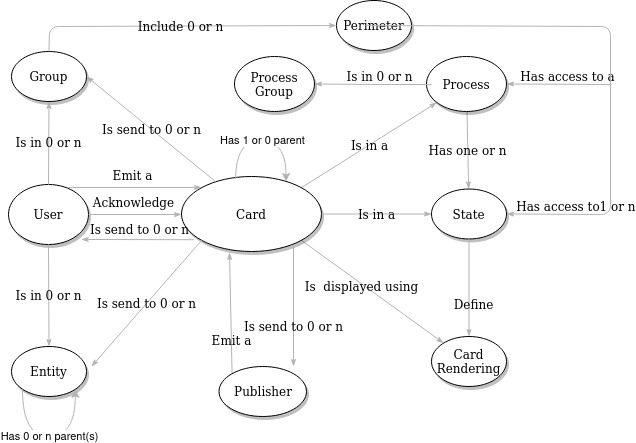
-
Card : the core business object which contains the data to show to the user(or operator)
-
Publisher : the emitter of the card (be it a third-party tool or an entity)
-
User : the operator receiving cards and responding via response cards
-
Entity : an entity (containing a list of users) , it can be used to model organizations (examples : control center, company , department… ) . An entity can be part of another entity or even of several entities.
-
Group : a group (containing a list of users) , it can be used to model roles in organizations setting the group type to 'ROLE' (examples : supervisor, dispatcher … ) and it can be used to define the rights on business processes by setting the group type to 'PERMISSION' (example: GROUP_ALLOWED_TO_SEND_CARD_PROCESS_X)
-
Process : the process the card is about
-
Process Group : a way to group processes on the user interface
-
State : the step in the process
-
Perimeter : for a defined group the visibility of a card for a specific process and state
-
Card Rendering : data for card rendering
A card can have a parent card, in this case the card can be named child card.
3. Technical Architecture
The architecture is based on independent modules. All business services are accessible via REST API.
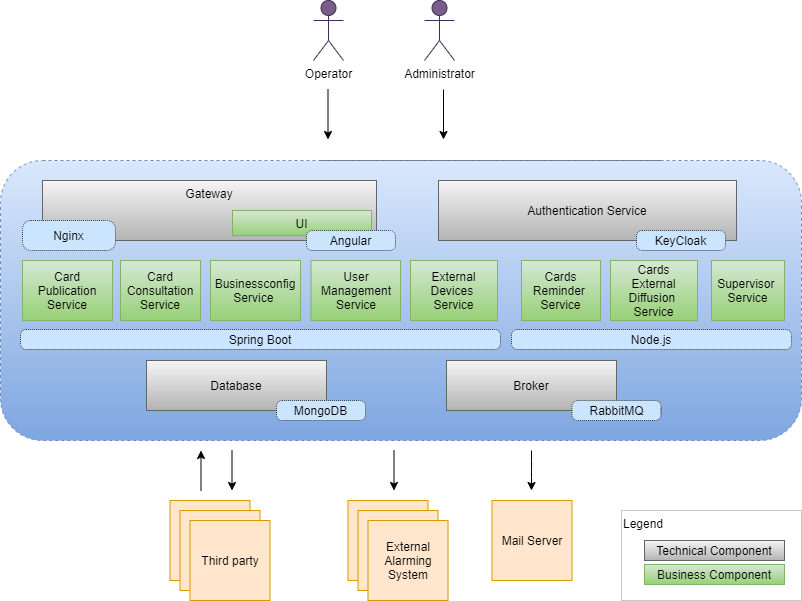
3.1. Business components
We find here the business component seen before:
-
We have a "UI" component which stores the static pages and the UI code that is downloaded by the browser. The UI is based an Angular and Handlebars for the card templating.
-
The business component named "Card rendering and process definition" is at the technical level known as "Businessconfig service". This service receive card rendering and process definition as a bundle. The bundle is a tar.gz file containing
-
json process configuration file (containing states & actions)
-
templates for rendering
-
stylesheets
-
internationalization information
-
Business components are based on SpringBoot or Node.js and are packaged via Docker.
Spring WebFlux is used to provide the card in a fluid way.
3.2. Technical components
3.2.1. Gateway
It provides a filtered view of the APIS and static served pages for external access through browsers or other http compliant accesses. It provides the rooting for accessing the services from outside. It is a nginx server package with docker, this component contains the angular UI component.
3.2.2. Broker
The broker is used to share information asynchronously across the whole services. It is implemented via RabbitMQ
3.2.3. Authentication
The architecture provides a default authentication service via KeyCloak but it can delegate it to an external provider. Authentication is done through the use of Oauth2, three flows are supported : implicit, authorization code and password.
3.2.4. Database
The cards are stored in a MongoDb database. The bundles are stored in a file system.
4. Software architecture
| The current software does not yet fully follow the architecture described here, it is a work in progress. |
4.1. Back Architecture
The main idea is to make the business code as technology independent as possible. This means that the business code should be independent of the Spring Framework or Node.js for example. Inspired by the hexagonal architecture, this leads to the following simplified view:
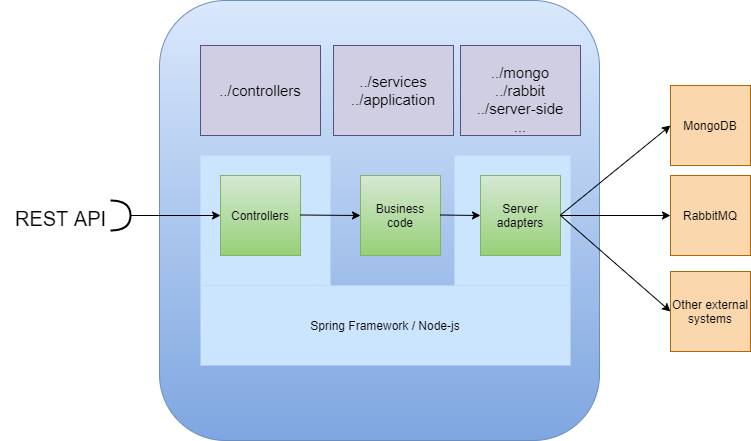
Unit testing consists in testing the business code and using mock objects to simulate the servers (mongoDB, rabbit …)
4.2. Front Architecture
The main idea is to make the business code as technology independent as possible. This means that the business code should be independent of the Angular Framework for example. Inspired by the hexagonal architecture, this leads to the following simplified view:
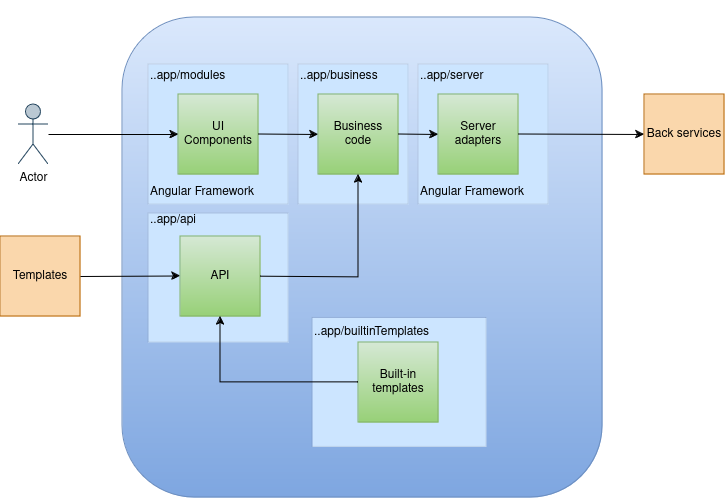
The UI components shall contain as little as possible business code.
The API component is a gateway to access business method, it shall not contain any logic.
Unit testing consists in testing the business code and using mock objects to simulate the servers (in app/tests/mocks)